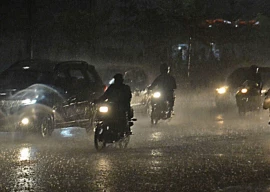
The power sector is one place where the sun never shines. From finance to trade, from the State Bank to the water bureaucracy, all those departments of government whose work touches on economic policy in any way are bound by legislation to release a set of data about their respective domains according to certain schedule. The power sector is one big exception to this disclosure requirement, and this exception needs to be rectified.
The State Bank, to use one example, maintains one of the most rigorous disclosure regimes in our country. Every fortnight, for instance, it releases data regarding monetary aggregates which if read properly can tell you a great deal about where the money is coming from and where it is going. Every three months it releases its quarterly report which gives a detailed snapshot of where things stand in the economy in areas as diverse as banking and manufacturing. Every year it releases its annual report, and sometimes makes quite a splash with it too. Look on their website and you’ll find regular data being released on the conduct of treasury bill auctions to deposits of scheduled banks to non performing loans to assessments of the health of the financial sector.
Similarly the finance ministry is bound by legislation to disclose key data as well. You’ll find fiscal data as well as the all important Economic Survey available on their website. Likewise, trade data is available in detail from the Federal Board of Statistics, and from the State Bank as well, and water discharges and inflows into the major dams and barrages can be obtained from Wapda.
But when it comes to the power sector, there is nothing. The channels report numbers for daily deficit between supply and demand for electricity when riots erupt in the streets, but even this number is obtained ‘informally’ from the Pepco spokesman who is under no legal compulsion to provide it, nor to explain how the figure has been arrived at.
Try getting the following data: fuel stocks at the Gencos, daily power ‘purchased’ from the Gencos, from Wapda and the IPPs, and monthly or quarterly transmission and distribution losses. This basic operational data which will tell you a little bit about the health of the power sector, but none of it is disclosed.
Besides operational data, there’s also financial data. The ease with which bulk consumers are able to contest Pepco’s bills tells us how dubious their billing methodology is, and this dubiousness grows out of the lack of transparency in Pepco’s operations. Dubious billing then leads to dubious claims on losses, and equally dubious demands to hike the tariff by ‘124 per cent’ in order to fix Pepco finances.
Of course, Pepco is not a listed company, and therefore has no compulsion to maintain a professional chief financial officer (CFO) like PIA or KESC or OGDC or PPL. No professional CFO means there aren’t any cash flow statements that one can take seriously in our power sector, leaving critical decisions like tariff adjustments to be made on dubious data.
Visit their website as an example and click around. Under the tab ‘News & media’ for instance, you’ll find the last entry is from 2010. Apparently, Pepco has no news for the media since that date. Under a tab called ‘Subsidies’, entries for tariffs stop in 2009, giving the impression that power tariffs have not been adjusted since then. And so on. The whole site is full of useless and outdated information.
It doesn’t have to be this way. We know that internally Pepco maintains a reasonably rigorous reporting stream on operational data. Financial data is another story. But operationally, we know that daily reports are received in Lahore from Gencos all over the country on details from flue gas emissions to megawatt hours of electricity produced. At any point in time, Pepco’s internal operational data stream can tell you how much electricity each turbine in each Genco is producing, and what the composition of the flue gas emissions is from each individual smokestack. They can also tell you how much gas is being received from their stipulated supplier and what the furnace oil stock position is in each storage tank. In short, operational data exists in substantial detail, is collected on a daily basis and transmitted to the headquarters. But there the stream stops.
Two things are needed very urgently. One is to develop a template for the disclosure of regular data by the power bureaucracy. The template should include daily requirements, fortnightly, monthly, quarterly and mandate an annual report. The second thing is to draft and pass the legislation that would make this disclosure regime legally binding on the Pepco management. Both the State Bank and the finance ministry are bound by legislation to release a minimal amount of critical data according to a predetermined template and schedule.
Data disclosure of this sort is critical for two main reasons. First it provides a benchmark against which to measure performance and to hold management accountable. It’s fair to expect that some tampering takes place with the data, but too much tampering sets off alarm bells, like what happened with the poverty figures released under Musharraf’s regime, based on the PSLM survey of 2004.
The second reason is that such data releases allow media and other professional bodies to monitor events closely. Think about how the media raises an alarm every time government borrowing from the State Bank begins to rise. This is because we know that this borrowing will result in inflation down the road. Mandatory disclosure regimes make it possible to anticipate the arrival of a major event, like inflation or a slide in the value of the currency brought on by a ballooning deficit in the external account. Such a disclosure regime needs to be mandated upon the power bureaucracy as well, to limit the space where discretionary and arbitrary numbers are cooked up, and to create a data series that can become the benchmark to measure Pepco’s performance and to anticipate the arrival of major events like a strong spike in demand, or dip in supply of power.
Published in The Express Tribune, April 19th, 2012.
COMMENTS (3)
Comments are moderated and generally will be posted if they are on-topic and not abusive.
For more information, please see our Comments FAQ














































That may be because the authorities don't want people to know how much they suffer due to electricity diverted to nuclear weapons production.
Khurram.
Excellent, as usual.
But I dispair. Does anyone read this and are they moved?
I suspect not, but that should not deter you from firing away.
Keep it up and keep pushing.
Thanks for shedding some light on internal operations of power sector. It seems like their supply side reporting is reasonable (though not published) but their delivery side reporting is not comprehensive enough or there is too much corruption in delivery side because of which reliable information is not available even internally on actual consumption per customer (and therefore wrong bills), line loss details, and generation / delivery costs. Consequently, it is useless to expect accurate capacity projections (along with long-term capital requirements), which is one of the reasons we stand in such a mess.